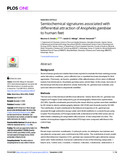| dc.description.abstract | Background
Several human-produced volatiles have been reported to mediate the host-seeking process under laboratory conditions, yet no effective lure or repellent has been developed for field application. Previously, we found a gradation of the attractiveness of foot odors of different malaria free individuals to Anopheles gambiae sensu stricto Giles. In this study, foot odor of the individual with the most attractive ‘smelly’ feet to the An. gambiae was collected, analyzed and attractive blend components identified.
Methods
The foot odor of the individual with the most attractive ‘smelly’ feet to the An. gambiae was trapped on Porapak Q and analyzed by gas chromatography-linked mass spectrometry (GC-MS). Specific constituents perceived by the insect olfactory system were then identified by GC-linked to electro-antennography detector (GC-EAD) and characterized by GC-MS. The contribution of each constituent to the behavioral response of An. gambiae was assessed through subtractive assays under semi-field conditions in a screen-house using Counter Flow Geometry (CFG traps) baited with (i) the blend of all the EAD-active and (ii) other blends containing all components with exclusion of one component at a time. The number of mosquitoes trapped in the baited CFG traps were compared with those in the control traps.
Results
Eleven major and minor constituents: 2 carboxylic acids, six aldehydes, two ketones and one phenolic compound, were confirmed to be EAD-active. The contribution of each constituent to the behavioral response of An. gambiae was assessed through subtractive assays under semi- field conditions. Exclusion/ subtraction of one of the following compounds: i-butyric acid, i-valeric acid, n-octanal, n-nonanal, n-decanal, n-dodecanal, undecanal or n-tridecanal, from each blend led to reduction in the attractiveness of all the resulting blends, suggesting that all of them are critical/important for the attractiveness of the foot odor to An. gambiae mosquitoes. However, exclusion/subtraction of 4-ethoxyacetophenone, 4-ethylacetophenone and/or 2-methylphenol, led to significant enhancements in the attractiveness of the resulting blends, suggesting that each of these compounds had repellent effect on An. gambiae ss. Undecanal exhibited kairomonal activity at low natural concentrations under semi-field conditions but repellent activity at high unnatural conditions in the laboratory. Furthermore, the comparison of the mean mosquito catches in traps baited with the nine-component blend without 4-ethoxyacetophenone, 4-ethylacetophenone and the complete foot odor collection revealed that the former is significantly more attractive and confirmed the repellent effect of the two carbonyl compounds at low natural concentration levels.
Conclusion
These results suggest that differential attractiveness of An. gambiae to human feet is due to qualitative and/or qualitative differences in the chemical compositions of the foot odors from individual human beings and relative proportions of the two chemical signatures (attractants versus repellents) as observed from the ratios of the bioactive components in the foot odors of the most attractive and least attractive individuals. Chemical signature means the ensemble of the compounds released by the organism in a specific physiological state. The chemical signature is emitter-dependent, but does not depend on receiver response. Thus, there is only one chemical signature for one individual or species that may eventually include inactive, attractive and repellent components for another organism. The nine-component attractive blend has a potential as an effective field bait for trapping of malaria vectors in human dwellings. | en_US |
| dc.subject | Semiochemical,signatures, associated,differential,attraction,Anopheles, gambiae, human,feet | en_US |

